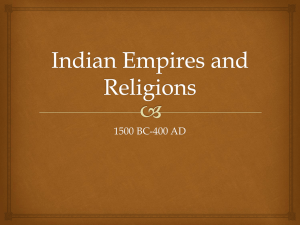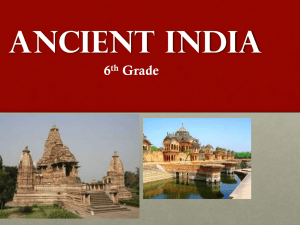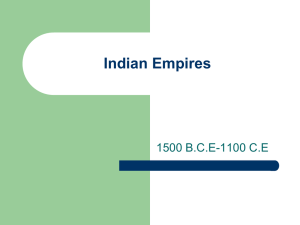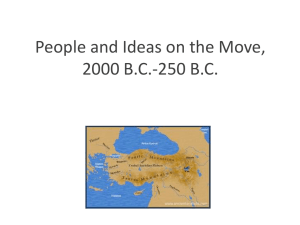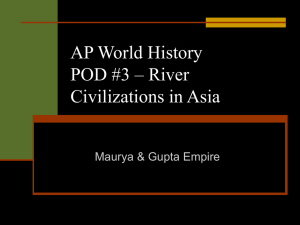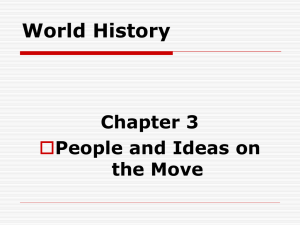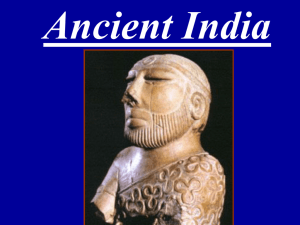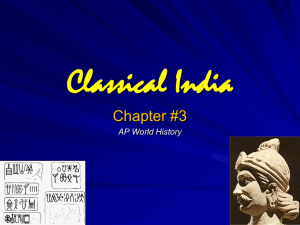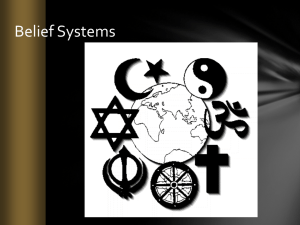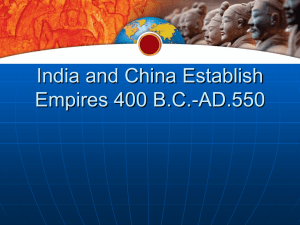DOP6 Chapter 04 - Stevenson Middle School
advertisement
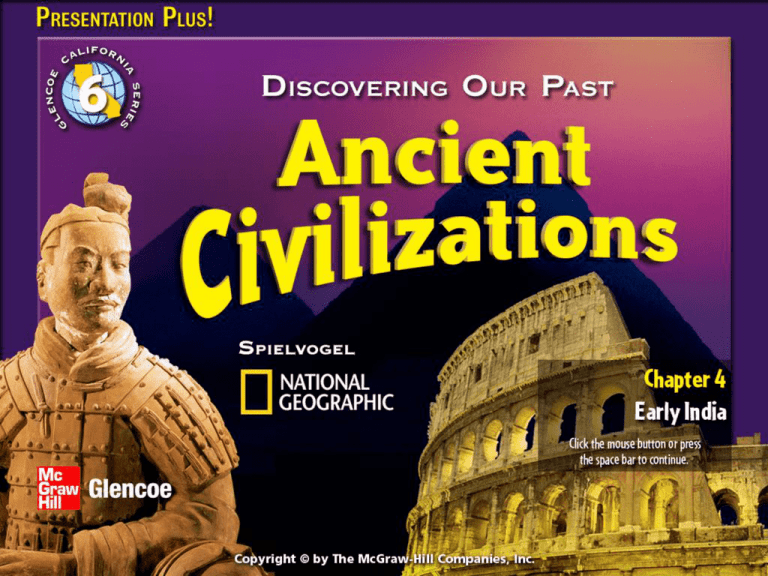
Chapter Introduction India’s First Civilization Hinduism and Buddhism India’s First Empires Chapter Assessment India’s First Civilizations People’s social status affects how they live. The earliest Indian civilization developed on the Indus River. Later, the Aryans arrived in northern India. A social system that determined how people lived evolved. Hinduism and Buddhism Religion shapes how culture develops, just as culture shapes how religion develops. India’s two main religions were Hinduism and Buddhism. These two religions affected every aspect of people’s lives. India’s First Empires Civilizations are strengthened by a variety of advances. Early India had two great empires: the Maurya and the Gupta. Both empires made advances in the arts, sciences, and math. In India, just as in Egypt and Mesopotamia, the first civilizations developed in fertile river valleys. • Climate and geography influenced the rise of India’s first civilization. (page 239) • For the Indian civilization, new ideas and technology developed. (page 242) • The Aryans created a caste system that separated Indians into groups. (page 243) Himalaya Ganges River Indus River Deccan Plateau Harappa Mohenjo-Daro Aryans Brahmins subcontinent raja monsoon caste Sanskrit guru similar individual As dangerous as monsoon flooding can be, drought is much more devastating to the people of India. In 1770, the rains did not come, and a famine occurred because of the drought. About 10 million people died in Bengal, an Indian state. I. The Land of India (pages 239–241) A. India is a subcontinent because it is separated from the rest of Asia by the Himalaya, the highest mountains in the world. B. Today the Indian subcontinent holds six nations: India, Pakistan, Bhutan, Bangladesh, Nepal, and Sri Lanka. C. India has two fertile river valleys created by the Ganges River and the Indus River. D. A monsoon is a strong wind that blows one direction in winter and the opposite direction in summer. Monsoons bring rain in summer. I. The Land of India (pages 239–241) Click the map to view a dynamic version. I. The Land of India (pages 239–241) E. Early civilization arose near the Indus River after the river flooded and left fertile soil behind. This civilization started about 3000 B.C. and lasted until about 1500 B.C. F. Harappa and Mohenjo-Daro were large, well-planned cities in ancient India. G. The cities had wells, drains for wastewater, garbage chutes, and organized governments. The houses were made from baked mud bricks. I. The Land of India (pages 239–241) I. The Land of India (pages 239–241) H. Most people were farmers. They grew wheat, barley, peas, and cotton. City dwellers were artisans who made jewelry, pottery, tools, and cloth. The Harappans traded their goods with people from other lands. I. The Land of India (pages 239–241) Why do archaeologists think that Harappan religion and politics were closely connected? The royal palace and the temple were enclosed in the fortress. II. The Aryans (pages 242–243) A. The Aryans came from central Asia where they raised and herded cattle. Some historians believe they were part of a larger group referred to as Indo-Europeans. B. The Aryans were expert warriors and hunters. They had metal-tipped spears and wooden chariots. C. The Aryan civilization expanded into all of the Indian subcontinent except the southern tip of India. D. The Aryans became farmers but continued to raise cattle. The cattle were so important, the Aryans eventually declared them sacred. II. The Aryans (pages 242–243) Click the map to view a dynamic version. II. The Aryans (pages 242–243) E. The Aryans invented an iron plow and built canals to improve farming. F. The Aryans’ written language was called Sanskrit. G. Aryan tribes were led by a raja, or prince. II. The Aryans (pages 242–243) Why were cattle such a prized possession? They provided meat, milk, and butter and were used as money. III. Society in Ancient India (pages 243–245) A. A caste is a social group that someone is born into and cannot change. B. The Aryans believed in four classes, called varnas. The top two varnas were Brahmins, or priests, and Kshatriyas, or warriors who ran the government and army. The next class included common people, such as merchants and farmers. Below them were laborers and servants. The lowest level did not belong to any varna. These people, called the Untouchables, did work others did not want to do. III. Society in Ancient India (pages 243–245) III. Society in Ancient India (pages 243–245) C. Men had more rights than women. D. Typically, only sons could inherit property. Only men were allowed to go to school or become priests. A boy from the top of society was often taught by a guru. E. Parents arranged marriages, and divorce was not allowed. III. Society in Ancient India (pages 243–245) Under the caste system in India, what aspects of life were affected by a person’s caste? A person’s caste affected what job one had, who one married, and who one could socialize with. • India’s first civilization, including the cities of Harappa and Mohenjo-Daro, developed in the fertile Indus River valley. • The Aryans, a group of nomadic herders, arrived in northern India about 1500 B.C. They brought the iron plow and the Sanskrit language to India. • India’s caste system divided people into rigid social and economic classes. Ancient Indian society favored men over women. 1. Describe the cities of Harappa and Mohenjo-Daro. The cities had wide streets and walled neighborhoods; mud brick houses around courtyards; public wells, sewage, and garbage disposal. 2. Why are monsoons important to Indian farmers? They cause soil-enriching floods. (3) CA 6RC2.7 3. Cause and Effect Why did the Harappan civilization collapse? Harrappan civilization may have collapsed because of earthquakes, floods, the Indus River changing its course, and the Aryan invasions. (4) CA 6RC2.4 4. Cause and Effect Draw a diagram to show how the Aryans changed the lifestyle of the Indians. Charts should reflect information in the text. (5) CA 6RC2.3 (6) CA CS3. 5. The Big Ideas In what ways did the caste system affect the people who lived in India? The caste system forced them into a fixed way of life and it limited their rights. 6. Explain How did the Aryans control people in India? Possible answers include a strong military and the effects of the caste system. Much of Indian civilization is based on Aryan ideas and culture, which you learned about in the last section. One of the most important and longlasting contributions of the Aryans is the main religion of India, Hinduism. • Hinduism grew out of the ancient beliefs of the Aryans. (page 247) • A new religion, Buddhism, appealed to many people in India and other parts of Asia. (page 249) Nepal Tibet Siddhartha Gautama Dalai Lama Hinduism karma Brahman Buddhism reincarnation nirvana dharma theocracy affect area require aware In 1949, the country of Tibet was invaded by China. China still occupies Tibet and tries to expel Tibetan Buddhism. Tibetans who fail to denounce their religion or possess an image of the Dalai Lama, their religious leader, are punished. I. Hinduism (pages 247–248) A. Hinduism, the world’s third-largest religion, is one of the oldest religions. B. Hinduism began with the Aryan religion, which changed after borrowing ideas from conquered people of India. C. Brahman is the universal spirit made up of thousands of deities. D. The Upanishads are ancient sacred texts that describe the search for Brahman. I. Hinduism (pages 247–248) I. Hinduism (pages 247–248) E. Reincarnation is the idea of passing through many lives to reach Brahman. F. Dharma is the divine law of Hindus. This law states that Hindus must perform the duties of their caste. G. The consequences of how a person lives are called karma. I. Hinduism (pages 247–248) According to Hindus, what are the consequences of a good and a bad life? Hindus believe if a person lives a good life, then that person might be reborn into a higher caste. If the person lives a bad life, then the person might be reborn in a lower caste. II. Buddhism (pages 249–253) A. Buddhism is a religion founded by Siddhartha Gautama, the man who became known as the Buddha, or “Enlightened One.” B. Siddhartha Gautama was a prince who left his family and wealth to travel. In his travels, he saw much suffering and questioned the need for suffering. Legend tells he meditated under a tree for 49 days, and then he understood. For the rest of his life, Siddhartha traveled to tell people about his discovery. II. Buddhism (pages 249–253) C. Nirvana, a state of wisdom, occurs when a person gives up all desires. D. The core of Buddha’s teaching is called the Four Noble Truths. The Eightfold Path describes the steps to eliminate suffering. E. Buddhism divided into Theravada Buddhism and Mahayana Buddhism. Theravada Buddhists believe the Buddha was a great teacher, not a deity. Mahayana Buddhists believe the Buddha was a deity who came to save people. II. Buddhism (pages 249–253) F. Tibet is a country in central Asia where Mahayana Buddhism mixed with traditional Tibetan religion and Hinduism to create a special kind of Mahayana Buddhism. G. In Tibet, religious leaders, called lamas, headed the government. The Dalai Lama was the government leader, and the Panchen Lama was the religious leader. H. A theocracy is a form of government in which religious leaders head the government. II. Buddhism (pages 249–253) I. Jainism is another religion that challenged Hinduism. Jains believe in nonviolence to all living creatures and live a strict life. Ahimsa, the Jain practice of nonviolence, has influenced many people in modern times, including Mohandas Gandhi and Martin Luther King, Jr. II. Buddhism (pages 249–253) Why was Buddhism popular with people of lower castes? Buddha taught that a person’s life depended on the person, not the caste into which the person was born. He believed that a person could stop being reborn by following the Eightfold Path. This gave people in the lower caste hope. • Hinduism is an old religion with many deities. Hindus believe in reincarnation and that a person’s place in life is determined by his or her karma. • In the 500s B.C., Siddhartha Gautama founded the religion of Buddhism in northern India. According to Buddhism, a person who follows the Four Noble Truths and the Eightfold Path can achieve nirvana. 1. What are the Upanishads? The Upanishads are ancient sacred texts that describe the search for a universal spirit. 2. What is reincarnation? Reincarnation is passing through many lives. (3) CA 6RC2.4 3. Compare and Contrast Draw a chart like the one below. Then add details to compare the two main branches of Buddhism. Theravada: Buddha is a great teacher; Mahayana: Buddha is a god; Eightfold Path is too hard; worship Buddha instead (4) CA HI2. (5) CA HR4. 4. Analyze How has ahimsa influenced people today? Modern leaders used nonviolence to bring about change. 5. Explain What is the importance of the Four Noble Truths and the Eightfold Path? The Four Noble Truths and the Eightfold Path summarize the Buddha’s teachings. (6) CA HI3. 6. The Big Ideas How did the belief in reincarnation strengthen the caste system and provide hope for the lower classes? One’s position in society results from past acts. Lower classes hoped to improve their position in a future life. In the last section, you learned about Hinduism and Buddhism. Both religions developed when India was a land of small kingdoms. These rival kingdoms would be forced to unite, however, when foreigners invaded. • The Mauryan dynasty built India’s first great empire. (page 260) • The Gupta empire reunited much of northern India and became wealthy through trade. (page 264) • The Mauryan and Gupta empires made important contributions in literature, mathematics, and science. (page 265) Pataliputra dynasty stupa Chandragupta Maurya pilgrim Asoka Kalidasa dominate concept Following Buddhist ways, Asoka respected all life and even created hospitals for animals. I. The Mauryan Dynasty (pages 260–262) A. Chandragupta Maurya, an Indian prince, founded India’s first empire after Alexander the Great left India. This empire was called the Mauryan dynasty. B. A dynasty is a series of rulers from the same family. C. From the capital city of Pataliputra, Chandragupta controlled his dynasty by retaining a strong army and using spies. I. The Mauryan Dynasty (pages 260–262) I. The Mauryan Dynasty (pages 260–262) D. Many historians consider Asoka the Mauryan dynasty’s greatest king. E. After being a strong military leader, Asoka turned away from violence. He made a vow to live a peaceful life and follow Buddhism. I. The Mauryan Dynasty (pages 260–262) F. Asoka did many great things for his people. For example, he built hospitals and new roads and sent teachers throughout India to teach Buddhism. Laborers built thousands of stupas, or Buddhist shrines. G. The empire grew weak after Asoka’s death. The kings made poor decisions, and the Mauryan Empire fell. I. The Mauryan Dynasty (pages 260–262) What happened as a result of Alexander the Great’s invasion of northern India? Alexander the Great’s army weakened the people of India. After hundreds of years of conflict, the people could not resist Chandragupta. II. The Gupta Empire (page 264) A. After 500 years of fighting, another Chandragupta took power and founded the Gupta dynasty. B. After Chandragupta died, his son, Samudragupta, took over and expanded the empire. C. The Guptas ruled for about 200 years. They grew wealthy from trade with China and kingdoms in southeast Asia and the Mediterranean. II. The Gupta Empire (page 264) II. The Gupta Empire (page 264) D. Pilgrims were people who often used the trade routes to travel to a religious shrine or site. Visiting pilgrims helped make cities wealthy just as tourists make cities wealthy today. E. The Guptas were Hindus, and they made Hinduism the official religion. F. The golden age of art and learning in India was during the Gupta empire. II. The Gupta Empire (page 264) What advantage did the Gupta rulers have that the Mauryan rulers did not? The kingdom had gotten smaller before the Gupta rulers took power. The smaller kingdom was easier to rule. III. Indian Literature and Science (pages 265–267) A. The Vedas of India are sacred hymns and prayers used in religious ceremonies. The Vedas were recorded in Sanskrit after the Aryan people came to India. B. The epics Mahabharata and Ramayana are two sacred texts that are still famous in India today. Both tell about warriors and their brave deeds. C. Kalidasa was a writer who lived during the Gupta dynasty. His poem The Cloud Messenger is a popular Sanskrit poem. III. Indian Literature and Science (pages 265–267) D. Music was an important part in the religious and social lives of people of India. E. Remains of Indian art include mainly religious works made in stone. F. Aryabhata was a mathematician who lived during the Gupta dynasty. He was one of the first scientists to use algebra. III. Indian Literature and Science (pages 265–267) G. Mathematicians in the Gupta empire developed the symbols for the numbers 1 to 9 that we use today. They also invented algorithms and the idea of zero. H. Indians also developed ideas in astronomy and medicine. III. Indian Literature and Science (pages 265–267) What kinds of medical advances were made by Gupta doctors? Gupta doctors could set broken bones and perform surgeries. They also developed medical tools. One doctor even carried out an early form of plastic surgery. • The Mauryan empire, under leaders such as Chandragupta Maurya and Asoka, united most of India for over a hundred years. • The Gupta dynasty reunited northern India and grew wealthy from trade. • During the Mauryan and Gupta empires, the arts and sciences flourished in India. Several great sacred texts, including the Mahabharata and the Ramayana, came from this period. 1. Describe trade during the Gupta empire. Indians traded salt, cloth, and iron with Asia and the Mediterranean region. 2. What is the message of the Bhagavad Gita? It is noble to do one’s duty even when it is painful. (3) CA 6RC2.3 3. Organizing Information Draw a diagram to show the contributions of Indian mathematicians during the Mauryan and Gupta empires. Contributions include algebra, zero, infinity, symbols for 1–9, and algorithms. (4) CA HI2. 4. Analyze How did Asoka’s actions as king show his Buddhist beliefs? His improvements were for the overall good. He built hospitals and roads; sent missionaries throughout India and Asia; carved Buddha’s principles on pillars; and practiced religious tolerance. (5) CA 6WS1.3 5. The Big Ideas Create a time line showing the advances in art, science, and math in India. Include information telling why these advances were important. Time lines should be chronologically correct. (6) CA HI2. 6. Math Connection Why would the development of a number system be important in a civilization that depended on trade? A number system allowed people to keep records of transactions and to monitor the exchange of money. 1. Write a paragraph about the basic beliefs of Buddhism using the following words. reincarnation karma dharma Indicate the vocabulary word that best completes each sentence. a. stupa b. caste c. raja d. pilgrim e. theocracy f. dynasty ____ c 2. Each Aryan tribe was led by a ___. ____ e 3. In a ___, government is led by religious leaders. ____ f 4. A ___ is a line of rulers who belong to the same family. ____ d 5. A ___ travels to religious places. 6. What new technology did the Aryans introduce to India? Aryans introduced the iron plow and canals. 7. What was the purpose of the caste system? No one is sure, but it possibly was created to help the Aryans stay in power. 8. What is the link between the Aryans and Hinduism? Hinduism is rooted in the ancient beliefs of the Aryans. 9. Describe the differences between Hinduism and Buddhism. Hinduism: many deities and one universal spirit, Brahman; reincarnation; dharma and karma, castes; Buddhism: begun by Siddhartha; Four Noble Truths and Eightfold Path; nirvana; no castes 10. Which dynasty built India’s first great empire? The Mauryan dynasty built India’s first great empire. 11. What poem expresses many of Hinduism’s central beliefs? The Mahabharata expresses many of Hinduism’s central beliefs. (12) CA 6RC2.2 (13) CA 6RC2.7 12. Compare How do you think the Eightfold Path is similar to the Ten Commandments of Judaism? They both describe behaviors that believers must try to follow. 13. Analyze How does the Mahabharata reflect the ideals of ancient India? It teaches important religious and moral lessons. (14) CA CS3. 14. Explain How did the monsoons affect the development of India’s first civilizations? The summer monsoon made the Indus River flood, fertilizing the soil and leading to good farming. Surplus food led to specialization and civilization. (15) CA HI2. 15. Predict What do you think might have happened if Asoka had approved of the slaughter on the battlefield during his wars of conquest? Answers may include that wars might have continued during the Mauryan empire; the empire might have been larger; Buddhism may not have spread so quickly. Study the map below and answer the following questions. (16) CA CS3. 16. Human/Environment Interaction Why did Harappa and Mohenjo-Daro develop so near the Indus River? The Indus River gave them access to clean water and fertile lands. (17) CA CS3. 17. Place The winter monsoon winds come from the northeast. What makes the winds from that monsoon cold? The Himalaya make the winds from the winter monsoon cold. (18) CA CS3. 18. Location Name at least two natural features that protected Harappa and Mohenjo-Daro from invaders. Possible answers include the Thar Desert, Himalaya, and Hindu Kush. 27. When the Indus River flooded nearby land, it A forced early settlers to become nomads. B left behind rich, fertile soil perfect for farming. C destroyed the first Indian civilization, Harappa. D ruined crops and the people starved. 28. According to Siddhartha, the only way to find the truth about the world was to A give up all desires. B live like a hermit. C meditate for 49 days. D fast until you are nearly starved. CA HI3. How did the Mauryan and Gupta empires follow the Hindu idea of events occurring in cycles? Answers should include this sequence: rule by many rajas; formation of an empire; ineffective rulers, which led to the empire’s collapse; and repetition of the cycle. WH6.5 Students analyze the geographic, political, economic, religious, and social structures of the early civilizations of India. WH6.5.1 Locate and describe the major river system and discuss the physical setting that supported the rise of this civilization. WH6.5.2 Discuss the significance of the Aryan invasions. WH6.5.4 Outline the social structure of the caste system. WH6.5.7 Discuss important aesthetic and intellectual traditions (e.g., Sanskrit literature, including the Bhagavad Gita; medicine; metallurgy; and mathematics, including Hindu-Arabic numerals and the zero). WH6.5 Students analyze the geographic, political, economic, religious, and social structures of the early civilizations of India. WH6.5.3 Explain the major beliefs and practices of Brahmanism in India and how they evolved into early Hinduism. WH6.5.5 Know the life and moral teachings of the Buddha and how Buddhism spread in India, Ceylon, and Central Asia. WH6.5 Students analyze the geographic, political, economic, religious, and social structures of the early civilizations of India. WH6.5.6 Describe the growth of the Maurya empire and the political and moral achievements of the emperor Asoka. WH6.5.7 Discuss important aesthetic and intellectual traditions (e.g., Sanskrit literature, including the Bhagavad Gita; medicine; metallurgy; and mathematics, including Hindu-Arabic numerals and the zero). To navigate within this Presentation Plus! product: Click the Forward button to go to the next slide. Click the Previous button to return to the previous slide. Click the Section Back button return to the beginning of the section you are in. Click the Menu button to return to the Chapter Menu. Click the Help button to access this screen. Click the Speaker button to listen to available audio. Click the Exit button to end the slide show. You also may press the Escape key [Esc] to exit the slide show. Presentation Plus! features such as the Reference Atlas, History Online, and others are located in the left margin of most screens. Click on any of these buttons to access a specific feature.
